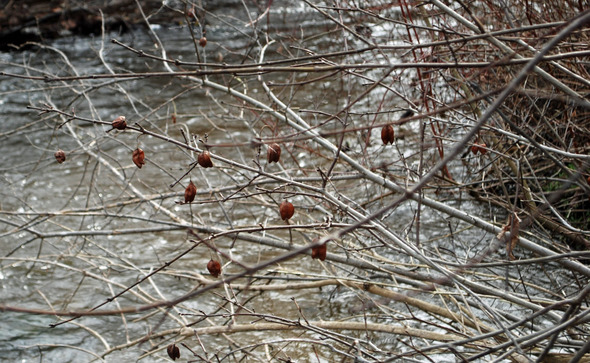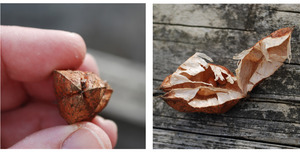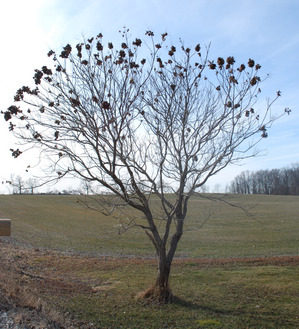American Bladdernut pods are a native flotation device

American Bladdernut (Staphylea trifolia) capsules hang on before dropping into the frigid waters of Fleming Creek in Matthaei Botanical Gardens and floating downstream, perhaps to the Huron River.
Rick Meader | Contributor
American Bladdernut is a shrub that is usually multi-stemmed and suckering. As you might guess from its common name, its "nut" is an air-filled capsule.
Just for a second, let's get technical, term-wise. True pods, according to the Free Online Dictionary, are "A dehiscent fruit of a leguminous plant such as the pea" or "A dry, several-seeded, dehiscent fruit." (Dehiscent means "opening by valves or slits"). So, the pods of the three previously discussed trees are actually pods. I didn't just make that up!
Capsules, on the other hand, according to the book "Michigan Trees" (Barnes and Wagner), are "a dry fruit of two or more carpels which splits at maturity to release the seeds." This is a better description of the bladdernut's fruit.
Bladdernut occurs naturally in the rich, alluvial soils along streams and river floodplains, and these capsules fall off and float their merry way downstream to spread their realm of influence further than mere gravity would allow. As you can see in the photo above, the papery casing holds three small seeds which rattle around in their case until it finally breaks open. They're fun to shake and play with if you happen to find one on a walk in the woods.

A capsule from the end, and looking into its innards.
Rick Meader | Contributor
The capsules begin life as a cluster of white, bell-shaped flowers about half an inch long, which bloom in April through May and are pollinated by insects such as bees (a great photo of them can be found at the Robert W. Freckmann Herbarium website.
Once pollinated, they develop into a cluster of green capsules that slowly change to brown as they mature. The plant itself is a good-sized shrub, which may reach a height of six to 15 feet, with a fairly erect habit and a spread about two-thirds of its height. It is usually multi-stemmed, with an overall look somewhat similar to hazelnut (although the photo below shows a specimen I found along Dell Road near Saline that is in a tree form).
Unlike the hazelnut (Corylus americana), however, this plant has compound leaves with three leaflets, oppositely arranged. I first encountered this plant in numbers at the Henry Ford Estate in Dearborn, where Jens Jensen had planted them in an upland setting, near the mansion. As mentioned before, though, they occur naturally along stream and river beds, and if you look at the natural range map for this plant, you can see that its range extends north of its main boundaries along rivers, where the temperatures are moderated by the water. It's pretty striking.
If you want to use this plant in your landscape, it is fairly tolerant of many situations, as long as the moisture is fairly constant (not droughty). It is tolerant of a range of soils and light situations, being tolerant of shade and sun.
They can form a pretty dense hedge, even after they lose their leaves in fall, which provides good cover for wildlife. This offers a good native substitution — instead of a somewhat dull privet or buckthorn hedge, you might consider planting a hedge of bladdernut, but give it some room to fill out. You can also plant a mass of this for a nice bird hideout. Unfortunately, its pale yellow fall color is nothing to write home about, so don't plan on it for that.

American bladdernut, in an unusual tree form, near Saline. Generally it is multi-stemmed, forming a dense mass of vertical stems from the ground.
Rick Meader | Contributor
While it doesn't provide a lot of food for wildlife, or for Native Americans, its capsules were useful for dances and rituals by the Meskwaki Indians and a wash or poultice was used by some tribes for a wash. According to a medicinal herb website, the seeds are also edible.
You may not have these uses for it, but if you have some room, and want to add some spring and winter interest, and provide food for bees and cover for birds, this could make a very nice addition to your yard. It’s not widely available in mainstream nurseries, but Native Plant Nursery in Ann Arbor and Wildtype Nursery in Mason both carry it. So, before you consider adding a non-native shrub to your yard, consider this native one.
The weird winter persists, but if you can't cross-country ski and enjoy the open woods, walking still works. Get out and enjoy nature, everyone!
Rick is a local landscape architect with a special interest in all things natural, including creating designs that include a lot of native plants (and the critters they support). You can contact him at yourland1824@gmail.com.

